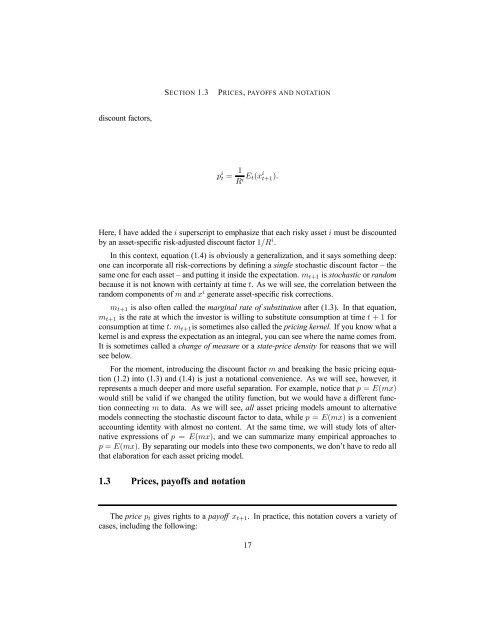Asset Pricing John H. Cochrane June 12, 2000
Asset Pricing John H. Cochrane June 12, 2000
Asset Pricing John H. Cochrane June 12, 2000
Create successful ePaper yourself
Turn your PDF publications into a flip-book with our unique Google optimized e-Paper software.
discount factors,<br />
SECTION 1.3 PRICES, PAYOFFS AND NOTATION<br />
p i t = 1<br />
R i Et(x i t+1).<br />
Here, I have added the i superscript to emphasize that each risky asset i must be discounted<br />
by an asset-specific risk-adjusted discount factor 1/Ri .<br />
In this context, equation (1.4) is obviously a generalization, and it says something deep:<br />
one can incorporate all risk-corrections by defining a single stochastic discount factor – the<br />
same one for each asset – and putting it inside the expectation. mt+1 is stochastic or random<br />
because it is not known with certainty at time t. As we will see, the correlation between the<br />
random components of m and xi generate asset-specific risk corrections.<br />
mt+1 is also often called the marginal rate of substitution after (1.3). In that equation,<br />
mt+1 is the rate at which the investor is willing to substitute consumption at time t +1for<br />
consumption at time t. mt+1is sometimes also called the pricing kernel. If you know what a<br />
kernel is and express the expectation as an integral, you can see where the name comes from.<br />
It is sometimes called a change of measure or a state-price density for reasons that we will<br />
see below.<br />
For the moment, introducing the discount factor m and breaking the basic pricing equation<br />
(1.2) into (1.3) and (1.4) is just a notational convenience. As we will see, however, it<br />
represents a much deeper and more useful separation. For example, notice that p = E(mx)<br />
would still be valid if we changed the utility function, but we would have a different function<br />
connecting m to data. As we will see, all asset pricing models amount to alternative<br />
models connecting the stochastic discount factor to data, while p = E(mx) is a convenient<br />
accounting identity with almost no content. At the same time, we will study lots of alternative<br />
expressions of p = E(mx), and we can summarize many empirical approaches to<br />
p = E(mx). By separating our models into these two components, we don’t have to redo all<br />
that elaboration for each asset pricing model.<br />
1.3 Prices, payoffs and notation<br />
The price pt givesrightstoapayoff xt+1. In practice, this notation covers a variety of<br />
cases, including the following:<br />
17
















